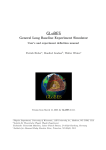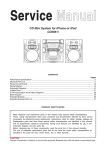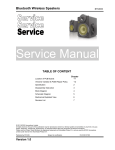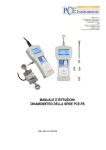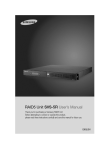Download Delta 210 Series Specifications
Transcript
Installation Instructions D- Series Issue Date October 6, 2003 D-70, D-140, D-210, and D-280 Series Electric Non-Spring Return Actuators Parts Included All Models • • Delta D- Series actuator To mount the actuator, proceed as follows: 1. Press and hold the gear release lever, and rotate the coupler to the 0 or 90° position. Release the gear release lever. (See Figure 1.) U-bolt with Clamp Nuts (2) Shaft Center DDA-160 anti-rotation bracket 90 two No. 12-24 x 1/2 in. self-tapping hex washer-head screws 0 • Mount D- Series actuators in any convenient orientation. Install the actuators on a 3/8 to 3/4 in. (9.5 to 19 mm) round shaft or a 3/8 to 5/8 in. (9.5 to 16 mm) square shaft, 2 in. (51 mm) or longer. If the shaft is less than 2 in. (51 mm) long, install an extension recommended by the damper or valve manufacturer. 60 30 30 Coupler 90 The D- Series actuators are IMPORTANT: intended to control equipment under normal operating conditions. Where failure or malfunction of a D- Series actuator could lead to an abnormal operating condition that could cause personal injury or damage to the equipment or other property, other devices (limit or safety controls) or systems (alarm or supervisory) intended to warn of, or protect against, failure or malfunction of the D- Series actuator must be incorporated into and maintained as part of the control system. 0 Installation (8, 16, 24, and 32 N·m) 60 D24-210 and D24-280 Include one DDA-105 pluggable 3-terminal block Gear Release D24-210-FB135 and D24-FB1K Include two DDA-105 pluggable 3-terminal blocks D24-210-A and D24-280-A Include three DDA-105 pluggable 3-terminal blocks Special Tools Needed • • torque wrench with 10 mm socket digital voltmeter or DDA-200 commissioning tool (for the models with zero and span potentiometers) Mounting IMPORTANT: The actuator is intended for indoor mounting only, with no direct exposure to water beyond NEMA 2 conditions. Use an appropriate shield or enclosure where the environment exceeds NEMA 2 specifications. © 2003 Delta Control Products, Inc. Part No. 34-636-836, Rev F A Anti-rotation Bracket Note: A is the distance from the center of the holes in the anti-rotation bracket to the center of the shaft. (See Table 1 for dimensions.) Figure 1: Mounting Positions Table 1: Shaft Sizes and Distances from the Anti-Rotation Bracket to Shaft Center Shaft Diameter A Dimensions (See F igure 1.) 5/8 in. 1/2 in. 3/8 in. 6-1/8 in. 6-3/16 in. 6-1/4 in. 155 mm 157 mm 159 mm 2. Bend or cut the anti-rotation bracket to fit the damper frame or duct as shown in Figure 2. 1 www.deltacp.com Slot for Bracket Anti-rotation Bracket Tab No. 12-24 Sheet Metal Screws (2) Anti-rotation Bracket Damper Frame Figure 2: Anti-Rotation Bracket Positions 3. Close the damper. 9. Press and hold the gear release. Rotate the coupler fully closed to fully open to verify that the damper and actuator rotate freely throughout the range. Rotation Range The actuator comes factory set for 0 to 90° rotation. To change the rotation range to less than 90°, use the top scale on the actuator cover, refer to Figure 3, and proceed as follows: 1. Press and hold the gear release, and rotate the actuator coupler Counterclockwise (CCW) to the 0° position. Release the gear release. Coupler 4. Insert the anti-rotation bracket tab into the slot at the bottom of the actuator (shown in Figure 2), and slide the actuator onto the shaft. Back of the Position Indicator Hub Actuator 90 0 IMPORTANT: The tab on the anti-rotation bracket must fit midpoint in the actuator slot to prevent actuator binding and premature wear. 5. Use the anti-rotation bracket as a guide, and drill the holes in the damper frame or duct for the bracket (based on the measurements obtained in Figure 1 and Table 1). 6. Attach the anti-rotation bracket to the damper frame or duct with the two self-tapping screws provided, using a 1/4 in. (7 mm) flat-blade screwdriver or 5/16 in. (8 mm) nut driver. IMPORTANT: Do not overtighten the mounting screws to avoid stripping the threads. 7. Slide the actuator onto the damper shaft, positioning the tab on the anti-rotation bracket midway into the slot at the bottom of the actuator. IMPORTANT: For Variable Air Volume applications that use a DM24-70 Series actuator, secure the coupler to the shaft with the damper in the fully open position to avoid damaging the open position end-stop. 8. Hold the actuator in place, and evenly hand tighten each clamp nut onto the U-bolt. Secure the U-bolt to the damper shaft by tightening clamp nuts to a torque of 100 to 125 lb·in (11 to 14 N·m). 2 60 30 0 Cover Screw 30 60 CCW 90 Gear Release Locking Clip Note: The locking clip is factory set at the missing tooth of the actuator hub for 90° rotation. Figure 3: Actuator Components 2. Turn the actuator over, use a flat-blade screwdriver to release the locking clip, and remove the coupler from the front of the actuator. 3. Reinsert the coupler into the front of the actuator, and align the position indicator with the starting point of the desired rotation range. IMPORTANT: Advancing the coupler 90° from the factory setting prevents the actuator from driving in either the Clockwise (CW) or CCW direction. 4. Push the coupler into the actuator until the locking clip snaps over the hub, securing it in place. Note: To change the rotation range on: • -A models with auxiliary switches, one or both of the switches may need adjustment. See the Auxiliary Switches (-A Models) section. • -Z and -Z-A models with zero and span potentiometers, adjust both potentiometers. See the Potentiometers (Proportional Models) section. D-70, D-140, D-210, and D-280 Series Electric Non-Spring Return Actuators Installation Instructions Feedback Signal For resistance-type feedback, the signal varies with a change to the rotation range. Resistance feedback reduction corresponds to the reduced rotation range. Refer to Figure 5 for the applicable D- Series actuator. Terminal B lock 1 1 2 3 ^- ~ + + ~ COM CW CCW For analog-type feedback, a change to the rotation range changes the feedback signal and the operating range proportionally. (See Figure 4.) 90° Direct Acting (DA) 0° Rotation Range Coupler Adjustment 75° 60° 45° 30° 15° 15° 30° 45° 60° 75° 0-10 V 10.0 V 8.3 V 6.7 V 5.0 V 3.3 V 1.7 V Feedback 2-10 V 10.0 V 8.7 V 7.3 V 6.0 V 4.7 V 3.3 V Feedback 0-10 V Reverse 0.0 V 1.7 V 3.3 V 5.0 V 6.7 V 8.3 V Acting Feedback 2-10 V (RA) 2.0 V 3.3 V 4.7 V 6.0 V 7.3 V 8.7 V Feedback Direct or 0-135 ohms 135 Ω 113 Ω 90 Ω 68 Ω 45 Ω 23 Ω Reverse Feedback Acting 0-1000 ohms1000 Ω 833 Ω 667 Ω 500 Ω 333 Ω 167 Ω Feedback Note: 0-10 V or 2-10 V is available on DM24 models. 0-135 ohms feedback is available on -FB135 models and 0-1000 ohms feedback on FB1K models. 24 VAC 24 VDC 0° 2.0 V 10.0 V 10.0 V 0Ω 0Ω Figure 4: Nominal Feedback Signal Relative to the Rotation Range Wiring 2 ~ + 3 ~ + COM CW CCW 24 VAC 24 VDC On/Off Control Floating Control Models: All D24 Series 90° 0.0 V 1 ^- 1 2 ~ ^ - + 24V 3 + 4 + 5 6 + + 0-20 mA 0-20V 0-10V 1 2 3 4 5 ~ ^ + + ^- + 24V CCW CW COM 6 + 100-10K ohms 0-10V Proportional Control Models: DM24 1 = Common 2 = Power 3 = Calibration Out (for -Z and -Z-A models only) 4 = Current Input 5 = Voltage Input 6 = Feedback Output Resistive Input Control Models: DRM and DRMS Note: Terminals 3 and 4 function as CCW and CW references when the Resistive models are in the DA mode but as CW and CCW references when these models are in the RA mode. Terminal B lock 2 ! CAUTION: Risk of Equipment Damage. Disconnect all power supplies before making wiring connections or prior to performing maintenance. Check all wiring connections before applying power to the system. Short-circuited or improperly connected wires will result in permanent damage to the equipment. IMPORTANT: Make all wiring connections in accordance with local, national, or regional regulations. Auxiliary Switches Switch Switch Switch S1 S1 S2 10° 80° 10° NC NO NO NC Switch S2 80° 21 22 23 24 25 C1 NC1 NO1 C2 NO2 NC2 (Shown Factory Set) (Shown Factory Set) Models: D24-70-A and Models: D24-210-A and D24-140-A D24-280-A Feedback Potentiometer CW CW 0% 100% 11 12 13 Models: D24-70 and D24-140 FB135 = 0 to 135 ohms FB1K = 0 to 1000 ohms 0% 100% Wiper (W) CCW CW Models: D24-210, D24-280 FB135 = 0 to 135 ohms FB1K = 0 to 1000 ohms Figure 5: Wiring Diagrams for D- Series Models D-70, D-140, D-210, and D-280 Series Electric Non-Spring Return Actuators Installation Instructions 3 Through the Conduit Openings Depending on the D- Series model selected, use one or both conduit openings. The threaded actuator conduit openings accept 1/2 in. trade size conduit fittings. Refer to Figure 6 and proceed as follows: 1. Loosen the cover screw with a Phillips No. 1 screwdriver, and remove the actuator cover. Cover Screw • one DM24-140 and one DM24-140-Z-A • one DM24-210 and one DM24-210-Z • one DM24-280 and one DM24-280-A Note: Do not use D24-70 or -140 or DM24-70 Series models in tandem. The Master/Slave Jumper is factory set in the master position. Determine the method for mounting the two actuators in tandem: front-to-back (Figure 7 shows the front view) or back-to-back and proceed as follows: Plugs (Conduit Openings) Figure 6: Location of the Conduit Openings 2. Push the plastic plug out of the conduit opening with fingertip. 3. Use the Phillips screwdriver to puncture a hole through the center of the plug, and reinsert the plug into the conduit opening. Note: For applications requiring metal conduit, thread the conduit fitting into the conduit opening and hand tighten. IMPORTANT: Use flexible metallic tubing or its equivalent with the fitting. Do not overtighten the conduit fitting into the actuator to avoid damaging the actuator threads. 4. Insert the cable wires through the plastic plug or conduit fitting, and connect to the terminal block using the applicable wiring diagrams in Figure 5. 5. Perform the procedures appropriate to the specific application, as described in the Tandem Operation and Setup and Adjustments sections. 6. Reattach the cover and tighten the cover screw. Tandem Operation The tandem configuration provides twice the torque of a single actuator as follows: 280 lb·in (32 N·m) for two DM24-140s, 420 lb·in (48 N·m) for two DM24-210s, or 560 lb·in (64 N·m) for two DM24-280s. The actuators operate in exact synchronization, ensuring the load is split evenly between each unit. Models with the same torque and control input may be mounted in tandem. For example: 4 Master/Slave Jumper W3 (Shown in the Master Position) Terminal Block 1: Common CW CCW Terminal 101 Terminal 102 Terminal 103 Terminal Block 2: Spade Terminals for Feedback Potentiometer on -FB135 or -FB1K and Auxiliary Switches on -A models (See Figure 5.) Figure 7: Settings on On/Off and Floating (D24-210 and D24-280) Models 1. Designate one actuator as the master, and move the Master/Slave Jumper on the other actuator to the slave position. 2. Connect Terminal 101, Terminal 102, and Terminal 103 from the master actuator to the corresponding terminals on the slave actuator. (See Figure 7 for D24 models and Figure 8 for DM24 models.) a. When mounting two actuators front-to-back on the same shaft, connect: • Terminal 101 from the master actuator to Terminal 101 on the slave actuator D-70, D-140, D-210, and D-280 Series Electric Non-Spring Return Actuators Installation Instructions • Terminal 102 from the master actuator to Terminal 102 on the slave actuator • Terminal 103 from the master actuator to Terminal 103 on the slave actuator b. When mounting two actuators back-to-back on the same shaft, connect: • Terminal 101 from the master actuator to Terminal 102 on the slave actuator • Terminal 102 from the master actuator to Terminal 101 on the slave actuator • Terminal 103 from the master actuator to Terminal 103 on the slave actuator Note: The total wire length for these connections may be up to 30 ft (9 m). Jumper W1 Direct Acting (DA) Reverse Acting (RA) Rotation Direction with Increasing Signal Factory Set (CW) DA (CCW) RA Note: Jumpers W1, W2, W3, and W4 have no effect when the actuator is in the Slave mode. Master/Slave Jumper (Shown in the Master position) Span Potentiometer Zero Potentiometer Jumper W2 Factory Set 3. Connect the input control signal: • For D24-210 and -280 models, connect the input control signal to the common, CW, and CCW terminals on both the master and slave actuators. (See Figure 7). • For DM24-140, -210, and -280 Models, connect the control signal to the master actuator and connect 24 VAC/VDC power to both the master and slave actuators. IMPORTANT: For proper tandem operation, do not connect the control input to the slave unit. Note: Set the master actuator jumpers on the DM24-140, -210, and -280 models according to the action and signal range desired before proceeding. (Refer to Figure 8 and the Setup and Adjustments, Calibration section.) 4. Make sure of the following if the actuators configured for tandem operation stall or do not drive: • Both actuators have the same torque and control input. • One actuator is set as the master and the other as the slave. • The control signal is connected to the master actuator only. • Terminal 101, Terminal 102, and Terminal 103 are connected properly, as described in Step 2. Voltage Input Current Input 0 to 20 mA 4 to 20 mA Feedback Ouput 2-10 VDC 0-10 VDC Jumper W3* Factory Set Adjustable Fixed * -Z or -Z-A Models Only Jumper W4 Factory Set Terminal Terminal Block Block11 101 102 103 123456 Auxiliary Switches (See Figure 5.) Voltage Input Feedback Output 1 Common 2 Power 3 Calibration Ouput (-Z or -Z-A Models Only) 4 Current Input 5 Voltage Input 6 Feedback Output Note: For current input, Jumper W4 must be in the 0 to 10 VDC position. Figure 8: Settings on Proportional (DM24) Models Setup and Adjustments Calibration Calibrate only the actuator designated as the master when using a combination of two D24-210 or -280 or two DM24-140, -210, or -280 models in tandem. Direction of Action In the DA mode, a minimum control signal drives the actuator to the full CCW position, and a maximum control signal drives it fully CW. In the RA mode, a minimum control signal drives the actuator to the full CW position, and a maximum control signal drives it fully CCW. To set an actuator for RA, proceed to the section for the appropriate model. IMPORTANT: Adjust the rotation range before changing the direction of action. D-70, D-140, D-210, and D-280 Series Electric Non-Spring Return Actuators Installation Instructions 5 On/Off and Floating (D24) Models To set one of these models for RA operation, reverse the control wiring connections at Terminal 2 and Terminal 3. (See Terminal Block 1 in Figure 5.) Proportional (DM24) and Resistive (DRM24) Models To set one of these models for RA operation, proceed as follows: without waiting for the actuator to drive to the final position. Adjusting the Zero and Span To adjust the zero and span potentiometers on the -Z and -Z-A models: 1. Verify that Jumper W2 is in the 0 to 10 VDC position, and provide 24 VAC or 24 VDC power to Terminal 1 (Common) and Terminal 2. 1. Press and hold the gear release, rotate the actuator coupler until it is in the full CW position, and release the gear release. 2. Connect the Common from the controller to Terminal 1, and either a voltage signal to Terminal 5 or a current signal to Terminal 4. 2. Move Jumper W1 from the factory-set DA position to the RA position. (See Figure 8.) 3. Connect Terminal 1 and Terminal 3 to a voltmeter to monitor the calibration output. 3. Apply power and then a control signal to the actuator to verify that the actuator is fully CW at minimum control input, and fully CCW at maximum control input. 4. Use a 1/8 in. (3 mm) flat-blade screwdriver to turn the zero potentiometer fully CW and the span potentiometer fully CCW. Note: The -Z and -Z-A models may require potentiometer settings. Proceed to the Potentiometers (Proportional Models) section. Jumpers On/Off and Floating (D24-210 and -280) models come factory-set with the Master/Slave Jumper in the master position, and have no additional jumpers. Proportional (DM24-140, -210, and -280) models come factory set with the Master/Slave Jumper in the master position. Proportional (DM24) and resistive (DRM24) models come factory set with Jumper W1 in the DA position. Proportional models have additional jumpers factory set as follows: Jumper W2 in the 0 to 10 VDC or 0 to 20 mA position, and Jumper W4 in the 0 to 10 VDC position. (See Figure 8.) 5. Apply the minimum (zero point) control signal required for positioning the actuator at the minimum position. 6. Monitor DC calibration output. To adjust the zero potentiometer, turn it CCW until the voltmeter displays 0 volts or slightly less. 7. Adjust the control signal to the maximum voltage desired to cause full rotation. 8. Monitor the calibration output at Terminal 1 and Terminal 3. Adjust the span potentiometer CW to increase the calibration output to 10 V. 9. Verify that the actuator is properly calibrated by adjusting the control signal to the minimum and maximum levels. Example for a zero of 3 VDC and a span of 5 VDC: Note: The -Z and -Z-A models have an additional jumper, Jumper W3, factory set in the fixed position. On/Off and Floating models do not have jumpers. • Apply a 3-volt control signal to the actuator, and turn the zero potentiometer CCW until the calibration output at Terminal 3 is 0 volts. Potentiometers (Proportional Models) • Apply maximum voltage. (In this case, it is 8 VDC, which results in a span of 5 volts.) • Monitor calibration output at Terminal 3, and adjust the span potentiometer CW to 10 volts. IMPORTANT: Adjust both zero and span potentiometers for full actuator travel and complete calibration. The -Z and -Z-A models have zero and span potentiometers that do not require adjustment when Jumper W3 is factory set in the fixed position. When Jumper W3 is in the Adjustable (ADJ) position, proceed as follows: Using either Terminal 3 and Terminal 5 or Terminal 3 and Terminal 4, a control signal, and a voltmeter, the zero and span potentiometers may be adjusted 6 Auxiliary Switches (-A Models) The -A models have two built-in auxiliary switches that allow setting at any angle between 0 and 90° (factory set for 10 and 80°, nominal). Refer to the Technical Specifications section for auxiliary switch ratings. The following procedures serve as examples to change the position of the auxiliary switch angles: D-70, D-140, D-210, and D-280 Series Electric Non-Spring Return Actuators Installation Instructions 4. Retighten the Phillips-head screw on Switch S1, while holding it in the designated position. Switch S1 To change the angle of Switch S1 to 20°, refer to Figure 9 and proceed as follows: Nodule Guides (10° Increments) 1. Depress the gear release, and using the 0 to 90° nodule guides, rotate the coupler until the position indicator is at 70°. Edge of Switch S1 2. Loosen the screw on Switch S2 with a Phillips No. 1 screwdriver. Position Indicator 0° 90° Plunger Switch S2 To change the angle of Switch S2 to 70°, (see Figure 9) proceed as follows: CCW CW Gear Release 3. Rotate Switch S2 CW, and align the edge of the switch with the plunger until the plunger rises. Edge of Switch S2 Figure 9: Switch Angle Settings 1. Depress the gear release, and using the 0 to 90° nodule guides, rotate the coupler until the position indicator is at 20°. Note: The normally closed contact opens, and the normally open contact closes. (See Auxiliary Switches in Terminal Block 2 of Figure 5.) 4. Retighten the Phillips-head screw on Switch S2, while holding it in the designated position. 2. Loosen the screw on Switch S1 with a Phillips No. 1 screwdriver. 5. Depress the gear release, and rotate the coupler until the position indicator is back to 0°. 3. Rotate Switch S1 CCW, and align the edge of the switch with the plunger until the plunger rises. Repairs and Replacement Note: The normally closed contact closes, and the normally open contact opens. (See Auxiliary Switches in Terminal Block 2 of Figure 5.) Do not field repair the D- Series actuators. To order a replacement or an accessory, refer to the Delta D-70, D-140, D-210, and D-280 Series Electric Non-Spring Return Actuators Product Bulletin (LIT-10000033). Technical Specifications Product Power Requirements (Class 2) Input Signal Input Signal Adjustments D-70, D-140, D-210, and D-280 Series Electric Non-Spring Return Actuators D24-70 and D24-140 Series: 20 to 30 VAC at 50/60 Hz or 24 VDC ±10%; 6.5 VA supply minimum All Other Models: 20 to 30 VAC at 50/60 Hz or 24 VDC ±10%; 7.5 VA supply minimum D24: DM24: DRM24: 24 VAC at 50/60 Hz or 24 VDC 0 (2) to 10 VDC, 0 (4) to 20 VDC, or 0 (4) to 20 mA Potentiometer value is 100 ohms minimum to 10,000 ohms maximum. D24: Factory Setting: Terminals 1 and 2, CW rotation; Terminals 1 and 3, CCW rotation DM24 (Voltage Input or Current Input): Factory Setting: -Z, -Z-A: DM24, DRM24: 0 to 10 VDC, 0 to 20 mA, CW rotation with signal increase Jumper Selectable: 0 (2) to 10 VDC, 0 (4) to 20 VDC, or 0 (4) to 20 mA Adjustable Zero, 0 to 6 VDC, 0 to 12 VDC, or 0 to 12 mA Adjustable Span, 2 to 10 VDC, 4 to 20 VDC, or 4 to 20 mA Action is jumper selectable Direct (CW) or Reverse (CCW) with signal increase. Continued on next page. . . D-70, D-140, D-210, and D-280 Series Electric Non-Spring Return Actuators Installation Instructions 7 Technical Specifications (Cont.) Input Impedance DM24: Voltage Input Current Input DRM24: Feedback Signal -FB135: -FB1K: DM24: DRM24: Auxiliary Switch Rating Mechanical Output (Running Torque) Audible Noise Rating Rotation Range Rotation Time (Each Series) -A: Enclosure Ambient Conditions Dimensions (H x W x D) Shipping Weight Agency Compliance Two Single-Pole, Double Throw (SPDT) switches rated at 24 VAC 1.5 A inductive, 3.0 A resistive, 35 VA maximum per switch, Class 2 45 dBA at 1 m 0 to 90° in 5-degree increments, mechanically limited to 93° D-70 Series: D-140 Series: D-280 Series: Mechanical Connection 135 ohm feedback potentiometer 1,000 ohm feedback potentiometer 0 to 10 VDC or 2 to 10 VDC for 90° (10 VDC at 1 mA), corresponds to input signal span selection. 0 to 10 VDC for 90° (10 VDC at 1 mA) D-70 Series: 70 lb·in (8 N·m) for one unit; not intended for tandem use D-140 Series: 140 lb·in (16 N·m) for one unit DM-140 (in tandem): 280 lb·in (32 N·m) for two units D-210 Series: 210 lb·in (24 N·m) for one unit D or DM-210 (in tandem): 420 lb·in (48 N·m) for two units D-280 Series: 280 lb·in (32 N·m) for one unit D or DM-280 (in tandem): 560 lb·in (64 N·m) for two in units D-210 Series: Electrical Connection 205,000 ohms for 0 (2) to 10 V and 410,000 ohms for 0 (4) to 20 V 500 ohms 1.8 megohms 30 s at 50% rated load 25 to 50 s for 0 to 70 lb·in (0 to 8 N·m) 80 s at 50% rated load, 70 to 115 s for 0 to 140 lb·in (0 to 16 N·m) 130 s at 50% rated load 115 to 175 s for 0 to 210 lb·in (0 to 24 N·m) 140 s at 50% rated load 115 to 205 s for 0 to 280 lb·in (0 to 32 N·m) D-210 Series and D-280 Series: 1/4 in. spade terminals with pluggable terminal blocks All Other Models: Screw terminals for 22 to 14 AWG; a maximum of two 18, 20, or 22 AWG per terminal 3/8 to 3/4 in. (10 to 20 mm) diameter round shaft or 3/8 to 5/8 in. (10 to 16 mm) square shaft NEMA 2, IP42 Operating: Storage: -4 to 122°F (-20 to 50°C); 0 to 95% RH, noncondensing -40 to 186°F (-40 to 86°C); 0 to 95% RH, noncondensing 7.09 x 3.94 x 2.54 in. (180 x 100 x 64.5 mm) 2.9 lb (1.3 kg) UL Listed, File E190867, CCN XAPX CSA Certified, File LR703029, Class 3221 02 CE Mark, EMC Directive 89/336/EEC Plenum rated in accordance with CSA C22.2 No. 236/UL 1995, Heating and Cooling Equipment. The performance specifications are nominal and conform to acceptable industry standards. For application at conditions beyond these specifications, consult Delta Control Products. Delta Control Products, Inc. shall not be liable for damages resulting from misapplication or misuse of its products. Delta Control Products, Inc. 2031 West Rose Garden Lane Phoenix, Arizona 85027 1-800-377-2600 8 Printed in U.S.A. www.deltacp.com D-70, D-140, D-210, and D-280 Series Electric Non-Spring Return Actuators Installation Instructions









